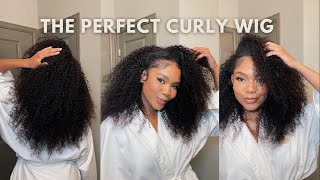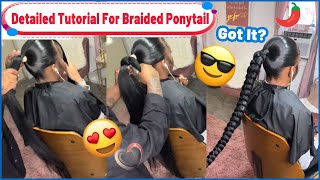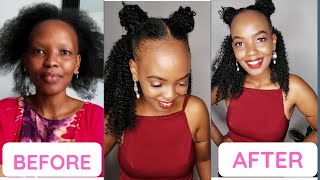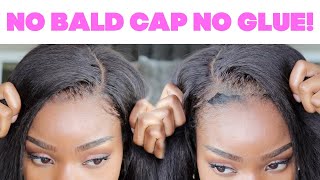4 Tips For Preserving Your Protective Style
 Protective styling is one of the best ways to help grow and retain long, healthy natural hair. Protective styling is also great if you want to manipulate and style your own hair less, like during the summer months or when you may be busy with other responsibilities.
Protective styling is one of the best ways to help grow and retain long, healthy natural hair. Protective styling is also great if you want to manipulate and style your own hair less, like during the summer months or when you may be busy with other responsibilities.
Even though protective styling keeps your hair out of the way, you still need to take care of it so that it can grow and flourish while it’s tucked away. Here a few tips for preserving your natural hair while protective styling:
Wash hair underneath
Protective styling is NOT an excuse to not wash your hair. In fact, if you go weeks or months without removing dirt and build up, your hair will actually stop growing because your scalp and hair follicle have been blocked.
While it may seem harder to wash your hair while protective styling, it can still be done. If you have a weave, fill an applicator bottle* with water and shampoo/conditioner and apply it between your tracks and braids. Rub the mixture into your scalp to cleanse before refilling the applicator bottle with pure water and rinsing your scalp clean.
If you have braids or twists, you can use an applicator bottle, or you can use a spray bottle filled with water and shampoo/conditioner. Rub into your scalp to cleanse before washing clean. With braids and twists it’s easier to do this method instead of standing in the shower and wetting your entire head, because otherwise the style will be heavier (which can start to pull at your edges), and it will take MUCH longer to dry.
Moisturize hair underneath
Moisturizing your hair is just as important as washing it while you have a protective style. Your natural hair should be moisturized before you install a style, and it should be re-moisturized often the entire time you protective style.
The extension hair that’s sometimes used when installing a style can be drying to natural hair, which is why it’s even more important to remember to moisturize.
With weaves*, fill an applicator bottle with a little water, some leave in conditioner*, and oil. Apply it between your tracks and massage it in every few days.
With braids and twists, you can again either use an applicator bottle* or spray bottle filled with the same mix. When moisturizing these styles, try to apply product down the length to where your natural hair stops. Otherwise, it’s a little pointless to moisturize synthetic braiding hair that you’re going to cut off.
When choosing a leave in conditioner* or other moisturizing product, try to look for something that doesn’t contain ingredients like dimethicone. Most ingredients that end in -cone are used to provide slip but they lead to more product build up that can only be washed away with harsh shampoos that contain sulfates.
Leave in conditioners that contain water, coconut oil*, shea butter*, glycerin, etc are very moisturizing for natural hair and won’t provide insane build up.
 Preserve hair at night
Preserve hair at night
Taking the extra two minutes to preserve your hair at night can make the difference in the overall look of your protective style and it means that you can protective style for a longer period of time. If you feel like your head just needs to hit the pillow as soon as you’re ready for bed (like me) then at least invest in a satin pillowcase*.
Satin pillowcases* are better than regular cotton pillowcases, because they don’t dry out your hair and they reduce frizz in the long term. Here are some other tips about preserving your protective style at night:
If you have a weave*, you can braid/twist the extension hair in large sections (depending on the hair texture) before putting it into a ponytail and putting either a satin scarf or bonnet on.
If you have braids or twists, it may be hard to get your hair into a ponytail with a normal scrunchie, so use a headband* to gather all of your hair together.
Be careful not to pull your hair back into a ponytail too tightly, especially if you have thicker braids, because this can wear on your edges after a while. Afterwards, tie a satin scarf around your head to keep the style from getting frizzy over time.
Touch it up as needed
Time flies when you’re rocking a protective style because all of your normal day to day natural hair obligations are tucked away. A month may pass and even though you aren’t yet ready to say goodbye, your hair may be ready for a change. If you don’t want to take your hair down yet, you can retouch the style to make it stretch a little longer.
If you have a weave*, you can get your braids redone or the tracks re-tightened so that they won’t hang as loose. If you have braids or twists, you can take out the first two rows around your entire head. Wash and condition the section before getting your hair redone.
Although the rest of your hair will be loose, you can make the style stretch for a few more weeks up to another month before totally taking it down.
Even if you decide to take a break from your hair and protective style, make the most of your effort by caring for your hair underneath. If you take the extra time to do these steps during your protective style, your hair will remain healthy underneath. It gets easier as you continue to do it, and your hair will definitely thank you in the long run.




